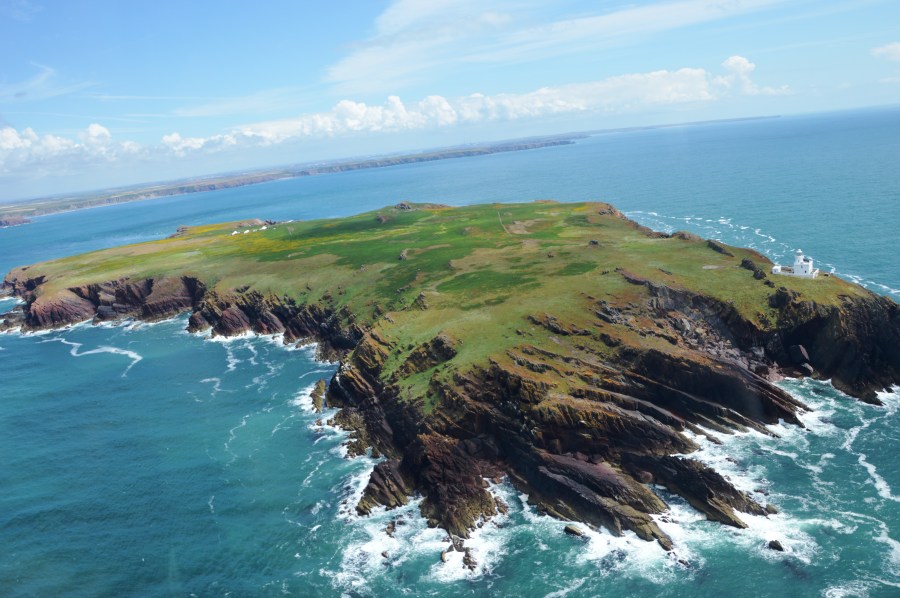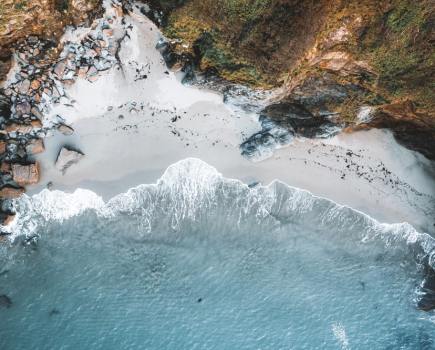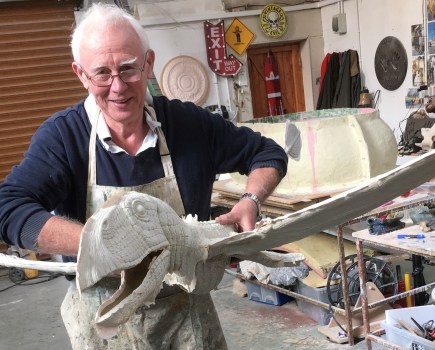Helicopter commutes, treacherous weather and puffin colleagues…all part of the nine to five for the people working on the UK’s most remote islands, discovers JENNY OLDAKER.
Clare Henderson is an archaeologist for the National Trust for Scotland, and since 2021 has been working on the remote islands archipelago of St Kilda, 40 miles west of the Outer Hebrides.

Scattered with evidence of a community that survived here for thousands of years, St Kilda is remarkable in terms of its archaeological significance, and Clare is responsible for monitoring the condition of the surviving ancient structures and for programming in any repairs. She spends around six to seven months on Hirta, the largest island, each year. Here, life and work are ruled by weather conditions; fine days involve long hours of fieldwork, while computer work is saved for wilder days. For an archaeologist, being hands-on at such an important site is a special experience: “Every stone I’ve replaced on St Kilda makes me think about how whatever I do in future, I left a small positive trace on this amazing place,” agrees Clare. “It feels like a tiny but unbreakable bond with the St Kildans themselves, who built these structures so long ago.”
And although the work doesn’t involve ‘digging’ things up Clare has even made a few discoveries: a small rock shelter, earthwork foundations of a building that were not previously known – and in a remote cleit (the stone storage ‘sheds’ unique to St Kilda) she found cut turfs left since the St Kildans departed nearly 100 years ago.
It’s hard to prepare yourself for what life will be like in a place like this, and one of the things that surprised Clare was how big the island of Hirta feels. “Its footprint is very small, but due to its volcanic origins it’s very vertical and rugged,” she says. “It takes several hours to walk from Village Bay in the south to the very northern tip of the island.”
Despite the remoteness, and missing friends and family, Clare cherishes her experiences on St Kilda: “I’ve watched the sun rise and set in the Atlantic from the hills, seen the full moon rising, meteor showers and the Milky Way. In 2021 we also had bioluminescence in the seas after dark – swimming in it was like millions of tiny fireworks as you moved…I spent the summer solstice on one of the hills, when it never really got dark.”
Richard Brown and Giselle Eagle are wardens on Skokholm, an important site for seabirds off the west coast of Pembrokeshire, which is owned by the Wildlife Trust of South & West Wales.
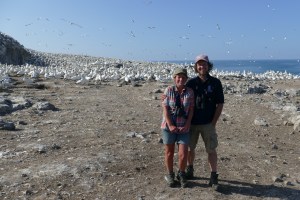
Skokholm is internationally important for its seabird colonies and their numbers have been monitored here for the past 100 years, providing a valuable historic record of populations and wider ocean health. Work continues today under the care of Richard and Giselle, who have been here for 11 years and are the island’s only residents.
The role of warden is diverse – not only are they in charge of monitoring birdlife, but also of taking care of the island, regular maintenance tasks and welcoming guests for six months of the year – up to 20 people come to stay on Skokholm each week during summer.
One of the biggest draws for these guests is the island’s puffin population, and bird lover Richard understands the attraction: “They are absolutely amazing – real personalities. I can (and do!) spend days and days just staring at puffins. Crab Bay has the densest puffin colony on the island and here they’re literally running across your feet and playing with your shoelaces. They’ve got so used to people that they just ignore them.”
Guests also get to enjoy the sound and spectacle of night displays from the swirling flocks of resident storm petrels, with these summer evenings rounded off around the log fire sharing the day’s sightings. “It’s a tradition here that goes back nearly 100 years,” explains Richard. “Everybody getting together on a night to say what they’ve seen – and that record of the island itself is an amazing dataset now.”
Skokholm is unusual in that there are no day-trippers, due to its exposed position and the impossibility of running a reliable ferry service, and stays can only be booked from mid-April until September. “Outside that period it gets too rough so you can’t guarantee people will be able to get off the island!” Richard says.
But there’s always work to be done on Skokholm so even after the last guests have departed Richard and Giselle remain. Their home on the island is in the imposing lighthouse, where they are based for around ten months each year: “It’s a dream come true for me,” enthuses Richard. “It’s out on the clifftop surrounded by the seabirds and the ocean, and facing west so we get amazing sunsets. It’s spectacular, even on the stormiest days.”
Coast Community: Our favourite coastal spots
Nick Chappell is a senior technician with Trinity House, the organisation dedicated to maintaining lighthouses around England, Wales, the Channel Islands and Gibraltar.
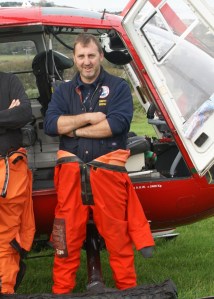
Since the role of the traditional lighthouse keeper became obsolete, these life-saving structures are kept in operation through the work of skilled technicians, who spend much of their working life in lighthouses around the British Isles, often in the remotest of locations.
Nick has been a senior technician with Trinity House for 37 years, and is generally away from home for around a couple of weeks each month, depending on the workload. “I’ll normally be at a lighthouse for ten to 12 days at a time,” he explains. “But it can be up to 21 days if we have a specific project to complete.”
Three engineers go out a time, dropped by helicopter, taking with them enough clothes and supplies for their time away. Each lighthouse requires a visit every six months: “We’re either doing a technical inspection or corrective maintenance,” says Nick
Wolf Rock is one of the remotest locations on Nick’s patch; a tiny volcanic rock nine miles off the coast of Land’s End, with its lighthouse looming dramatically from its centre. Nick explains how the experience of spending time in a place like this is fully dictated by the time of year and weather conditions: “In winter, when all the windows and doors are shut up, with the sea going over the top, it can feel a bit like being in prison. But in good weather you can actually get outside and sunbathe or do a bit of fishing and watch the wildlife when you’ve finished work for the day.”
The storms may be tough, but the high points make work on a remote lighthouse island worth it – from spotting basking sharks, sunfish and seals in the sea, to enjoying incredible sunsets from the middle of the ocean. “I get to visit so many different places, and life is always interesting in this job,” says Nick. “It really feels like a privilege to do what I do.”
Jonathan Ford is ranger on Papay Westray, one of the smallest of the Orkney Islands, off the north coast of Scotland. His role includes leading tours and setting up events and projects.
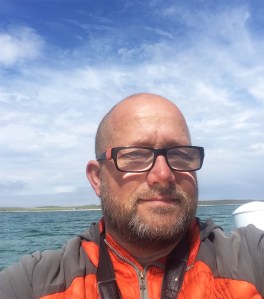
Known by the locals as Papay, this tiny island with a population of around 80 people punches well above its weight in terms of a cultural and social scene. This is in no small part down to the work of Jonathan who has been the ‘Papay ranger’ for the past eight years, backed up by a dynamic development trust and the proactive local community.
“The community here is the real backbone of the island,” says Jonathan. “Papay’s very much a ‘doing’ place – one of the things that made me want to move here in the first place. There’s a real will from local people to get involved and do things.”
Recent community projects include building traditional cassie wall sea defences, with local farmers sharing their stone-building skills. “Lots of the projects on Papay have this kind of thing built in – a passing on of the traditional skills of the island,” Jonathan explains. “When you live in a place like this it’s very self-determined – we look after the land and we set things up ourselves because no-one’s coming in from elsewhere to do it.”
The island is rich in archaeology and birdlife, and another big part of Jonathan’s role is to share these with guests who travel to Papay. “My role is quite visitor-led in the summer months, welcoming guests and taking them to these amazing places on the island. Though my favourite part of the job is running the boat trips – it’s quite magical out on the water and makes the winters worthwhile.”
Winter can indeed be tough out here – and can seem to stretch on for months on end. “I guess because I like to be outside and seeing things, winter’s hard as the light’s not great a lot of the time, and the birdlife recedes. It’s frustrating when you want to be outside and doing things.”
But Jonathan enjoys the intensity of seasonal changes in this remote, northerly spot. Places like this are at the sharp end of climate change too: “We see things very clearly here, whether it’s sea levels rising, coastal erosion or the disappearance of seabirds. Over recent decades seabird numbers here have plummeted.
“Thirty years ago there’d have been nearly 30,000 arctic terns here and now there’s probably no more than about 400 that come back every year. The kittiwakes have gone from nearly 8,000 to virtually nothing. You really notice the changes.”

